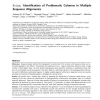Free Online Productivity Tools
i2Speak
i2Symbol
i2OCR
iTex2Img
iWeb2Print
iWeb2Shot
i2Type
iPdf2Split
iPdf2Merge
i2Bopomofo
i2Arabic
i2Style
i2Image
i2PDF
iLatex2Rtf
Sci2ools
ALMOB
2008
2008
Noisy: Identification of problematic columns in multiple sequence alignments
Motivation: Sequence-based methods for phylogenetic reconstruction from (nucleic acid) sequence data are notoriously plagued by two effects: homoplasies and alignment errors. Large evolutionary distances imply a large number of homoplastic sites. As most protein-coding genes show dramatic variations in substitution rates that are not uncorrelated across the sequence, this often leads to a patchwork pattern of (i) phylogenetically informative and (ii) effectively randomized regions. In highly variable regions, furthermore, alignment errors accumulate resulting in sometimes misleading signals in phylogenetic reconstruction. Results: We present here a method that, based on assessing the distribution of character states along a cyclic ordering of the taxa, allows the identification of phylogenetically uninformative homoplastic sites in a multiple sequence alignment. Removal of these sites appears to improve the performance of phylogenetic reconstruction algorithms as measured by various i...
| Added | 08 Dec 2010 |
| Updated | 08 Dec 2010 |
| Type | Journal |
| Year | 2008 |
| Where | ALMOB |
| Authors | Andreas W. M. Dress, Christoph Flamm, Guido Fritzsch, Stefan Grünewald, Matthias Kruspe, Sonja J. Prohaska, Peter F. Stadler |
Comments (0)

